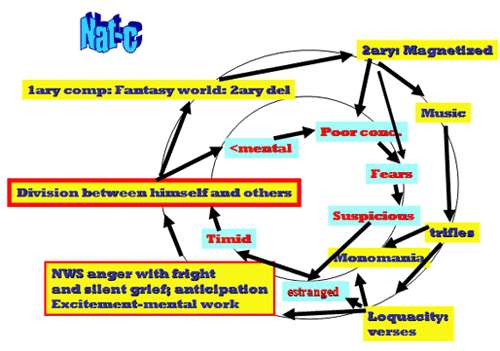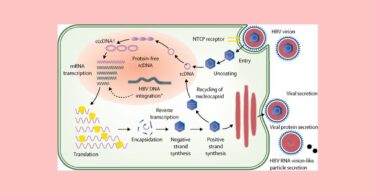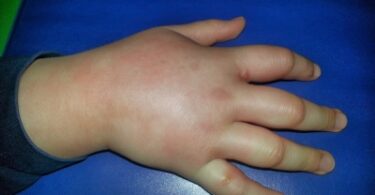Natrum-carb: The Flight Into a Dream World
With the Nat-c child we have to look at the Periodic Table to understand what this child is all about. We can easily understand the difficult life of this child when we see the elements Natrum and Carbonicum. Natrum belonging to the first group, is all about wanting to connect to others, very impulsive, spontaneous, even naïve, but it is the second part, that carbon, which mistunes her in her mission to connect. Carbon is stubborn, a primitive and archaic ego, very little differentiated and the child is stuck with no differentiation yet in her dominant function . The attention is still mainly aimed at the self (but not 100% like the pure carbon), and together with the stubbornness, leaves little place for others to impose their will or opinion (we see this easily in “intolerant to contradiction“). The child usually expresses this sentiment as, “I want to do this! Don’t help me!” It looks like this is a very independent child. The reality is very different. Independence in the case of Natrum is easily confused with and translated as loneliness. It is easy to see too why these children would be catalogued under the ASD as they have difficulties connecting to others, even if they are intimate friends or family: aversion to family members and to society and estranged from family and friends. And it has, company, aversion to, of intimate friends (2). There seems to be a contradiction to the Natrum element that is so desirous to connect to others, and the aversion to even family: this leads to the core delusion,
Del, there is a division between himself and others, which is also expressed by del, is forsaken and deserted (1) and fear of being alone, yet averse to company (3!). I remember such a child that would go so far to invite her friends at her home, but when they arrived went off playing by herself. How can that be in such a young child that has hardly lived? It must go back intra utero and these same feelings must be found in the pregnant mother! But for what reason can this behavior be present? It can only because the mother must have felt isolated and estranged from friends and family. What trauma can create such situation when happiness should be at a peak? Let’s have a close look at the “ailments from”. Ailments from anger with fright (1), and from anger with silent grief (1).
Such NWS recalls the cases of the young excited woman who might be pregnant for the first time, but her joy is tempered because of neglect, indifference, even anger from a husband who is not ready to have a family or fears that this baby will get all the attention. Maybe she felt, rightfully or not, forsaken by her family because “they did not get enthusiastic enough about her being pregnant.” Or maybe the pregnant mother was hoping that this child might be the peacemaker between her and her parents from which she is estranged and then it did not happen! Maybe the husband has to travel for his work a lot and family lives far away. It certainly would explain her anger and grief and her isolation from family. Sometimes, as is evidenced in the example below, the secret story is even more unbelievable, but then again, society is often quick to judge others without knowing the facts. Maybe both parents were not married yet and in a conservative family this can lead to all kinds of rejection: maybe an abortion is advocated strongly against her wishes, leading to estrangement from “well-meaning” friends and family who exclaim: “You are both too young. You are immature. You cannot afford this.” Or there can be a secret story of rape or incest. Is there any more horrible reason for being subdued about being pregnant? How can the pregnant mother express her joy to the world? And it does not have to be rape. There are enough Lycopodiums and Medorrhinums out there who abandon the pregnant mother right away, yet the mother is committed to the unborn child. Besides leading to ailments from anger with fright (“What am I going to do now with no help, who is going to help raising me this child?”) to anger with silent grief (They are too embarrassed to tell anyone they have been dumped), it all leads to ailments from anticipation anxiety (2) and emotional excitement (1-stress), two other NWS for Nat-c.
This combination of loneliness, stubbornness and immature ego coupled to shyness does not seem to be a good combination to overcome her sense of isolation. And indeed life is a struggle for this child. What positive tools, if any indeed, does she have to overcome all this?
As we have seen in the core delusion for Nat-c, the difficulty is entering the world, even the limited world of the child and connecting to others. What can we do to survive if we are not able to connect to anyone in this world? Creating our own fantasy world! This will be the primary compensation and all other ones are just in function of this first one as we will see. Indeed many fixed ideas are expressing this illusion created world: del, of fancy illusions (1). These are children that create stories by themselves in which they are the heroine, the controlling force over what happens in their own little world. These are children that seemingly are totally engrossed in their actions, playing with little cars or trains, while having earphones on listening to music. Other delusions allude to this fantasy world: Del, he is on a journey (as they are totally seemed to be disconnected from their environment). Del, of a wedding again shows the desire of connecting to a pleasant world and a sense of belonging somewhere, which in real life they seem incapable of achieving. Because these children are still young, they create a world of smallness in order to fit in that world, in order to be part of it: del, things appear small. Creating such small world (like carrying small toys everywhere around with them) is comforting to them: they are small but large in comparison with the little toys/stuffed animals they play with. See in the next example how this girl wants to “disappear in small crevices, in a lamp, etc.
This lack of intimacy results also in a desire to be magnetized and mesmerizing ameliorates. In other words, there is a desire to be supported, to be “carried” by someone. This mesmerized is more by their created fantasy visions, not by realities in life as there is a tendency to anthropophobia, misanthropy and especially fear for men. There is a continuous effort to try to make contact, but at the same time, they flee before any serious contact is made. When I mentioned music, we can’t expect that she will listen to fast rock and roll music like Tarentula: this does not fit at all her mood and even piano music creates anxiety. The best music for such a child is classical music from Walt Disney films (i.e., the “Beauty and the Beast,)” another dream world in which she can escape. The Natrum element certainly refers to the seriousness of the child (serious, earnest), also reflected in the kind of music she listens to. So this music is a positive tool, as it reinforces and resonates in her special world. But we should remember that the reaction to a serious child is seriousness; to a happy outgoing child, it will be laughter and play. From the beginning, this child unconsciously blocks avenues of reaching out to the rest of the world.
Another positive tool to connect to “a world,” (not the world) is her strong conscientiousness about trifles (3). However this easily leads to monomania and OCD, again mentioned in the spectrum of ASD: children play for hours lining up their little cars and get mad when someone interferes or they get attached to one or more objects, like always carrying around with them a certain little toy. Or the conversation is at nauseam about the same topic: one of the favorite things is observing and talking about small animals like insects such as lady bugs or little gold fish for which they show great concern (sympathy, compassion, 2). Therefore this remedy should be in the rubric, talking, one subject; of nothing but, where we find remedies like Arg-n, Lyc, Med and Stramonium Of course, the talking of one subject is very different in these remedies. Med and Lycopodium don’t talk about lady bugs but about the ladies (their sexual conquests); Arg-n talks about all the calamities that “can” happen when she leaves the home; there is always one more “what if this or that happens;” and Stramonium only talks about the dangers she possibly faces in this world. Nat-carb’s interest for detail is indeed a positive tool for the child as she uses it to a detail filled fantasy world but definitely can be a positive indicator for an ASD child.
We can see that all the positive tools of Nat-c, are really means to reinforce a permanent world in which she is able to live. If we see loquacity in Nat-c (a 2, the most loquacious of the Natrums and Nat-p is not even in this rubric as it means, “lack of communication), it is not to connect to others but more to connect to the figures in her created fantasy world to which she talks all the time (occupation ameliorates, 2). This lining up of toys and talking to the figurines and little soldiers must make you think of Calcarea carbonica, but the difference is that Calcarea carbonica is not at the stage yet where they are ready to go into the world (sometimes they never are even as an adult) and must connect to others than the immediate parent or family. Calcarea carbonica only just discovered himself and feels content in the safe environment of the home where he has no difficulties engaging with others. In fact he easily, through stubbornness and temper tantrums, can get all the attention he wants so much. Nat-c somewhere got lost and family does not represent that safe haven anymore as it is for Calc-c. Natrum wants to connect outside of the family with friends and others, but “something (NWS)” stops her from achieving this!
Once the Nat-c child knows how to read and write her loquacity takes on another form and her fantasy world expands with another positive tool: writing! She talks of verses and writes stories. You see the refinement of the Natrum again, as this is a way of communication with the outside world for Nat-c, a world that seems too difficult to reach. However this is only a “positive” compensation for the child as it will cut her more and more off from the real world who finds such person too serious and eccentric.
This limited arsenal of positive tools, which has only one purpose, creating a safe haven (a fantasy world) for the child, shows how difficult life in general will be for this child, even growing up. The isolation, if not sufficiently compensated by fantasy, will become more and more outspoken when the child grows up and comes in a structured environment like school where other mandatory and less desirable tasks are imposed. Mental work is not a positive tool: occupation ameliorates and attention to detail are not connected to school work as we have seen, rather to the creation of that fantasy world. Where Nat-m and even Nat-p in their initial phase have desire for mental work, Nat-c has mental work is impossible or fatigues (3!). This child needs time outs after spending barely 30’ on homework or lecture, something impossible in structured settings but better dealt with and certainly quicker found out in home schooling. There is quick confusion of the mind from mental exertion (3) and concentration difficult while studying and reading (2). No wonder these children, absorbed and buried in thought (in their fantasy world), have received every name in the manual of psychiatry: from OCD to ASD to ADHD!
We can see easily the furthering of isolation in this child confronted with these increasing difficulties in life. They even have the del, that the body has become heavy and thick, showing how difficult it is again to respond to exterior stimuli. How does one react negatively to isolation? It will be depending in what miasmatic phase of the remedy they are.
In their psoric phase it will be mainly with despair, fears and anxieties. There is much anticipation anxiety about anything that threatens their fragile little world: this is the child that watches the weather forecast and gets excited (not in the sense of wanting to watch it like Carcinosin and Sepia but fearing it) about the appearance of a storm, before, during and after! Thunderstorm aggravates: only Nat-c 3! Approach of thunderstorm a 2! Aggravates after thunderstorm: a1. They are easily frightened (3) and suffer from prostration of the mind and brain fag (3).
It goes to sycotic behavior like foolish behavior (Hyos, Tarent) and suspicious behavior: del, sees thieves and criminals. If the child does not get out of his isolation, he is doomed to live a life of loneliness, with continuing fears and slipping into syphilitic traits: indifference and apathy (3), with ennui; indolence to work; estrangement from friends and family, showing the dept of isolation; loathing of life waking up in the morning; malicious and spiteful; quarrelsome; gloom and sadness (3); striking from anger (2) and stupefaction on awaking. Couple this to timidity and bashful (3) and you see how we are returning to the core delusion of feeling an abyss between the self and others. The real danger if such child grows up and is still creating a fantasy world, that an emotional event can push the adult from this neurosis and delusions into a real psychosis (like schizophrenia).
A Natrum carb Case
C., a 5 Year old girl: CC: Very moody, changeable. It was a forceps delivery, after 2 days labor, the physician was in a hurry at this point. From the beginning she had acid reflux (Ph 1) and constipation. She was a very irritable baby, not breastfed. The regurgitation was helped with Propulsid (suppression) but the constipation remained. Only last couple of years more normal where before suppo’s were necessary. She is very tidy and fastidious: she lines up her toys to perfection and is fascinated with listening to classical music on her Walkman while she is watching her train zooming around. But she often says, “People are talking about me, they are laughing at me.” She loves wind, will go and stand in it. She is afraid of storms. She will watch the weather channel, and then becomes excited when one is coming! She cannot stand her nails to be cut neither her hair being brushed: she says, “It hurts!” She is independent, wants to do everything herself! Lately, especially the last 4 months, she has been saying to her older sister who is adopted: “But I came out of mommy’s tummy!” She loves “small things.” She has a little elephant that she carries around with her everywhere, also loves insects. She also says when she sees a lamp, a jar or a crevice, a little space, “I want to go in there.” She only likes classical music, not fast or country music, “That is boy’s music!” She tends to be a loner, she is insecure. She asks mom to invite friends and then when they show up, she does not do anything with them, tends to take off on her own (mom calls it “stand-offish”). She appears often sad. She likes wearing the same cloths and hates everything around her neck. She is into kissing, we cal her “kissy” as she is always kissing her younger brother (7 months). She is very responsible and serious. She wants a puppy and when she feeds the fish, she is concerned about the small fish whether they get enough food. She is home-schooled and she does have only an attention span of 30’. After that she needs to do something else. She likes computers and videogames. She does like routine, does not like new situations.
What is the pregnancy story: The parents were in the process of adopting after mom had gone through a lot of fertility drugs. They had already signed the papers when she found out she was pregnant! (for first time) Now she had intense fear that she would lose the other child (the adopted child) and fear of her present child, something going wrong with all that stress. In fact the natural mother found out and sued them for “fraud.” This lasted the whole pregnancy. As a result, when she found out that she was pregnant, she could not tell anyone out of fear that she would be labeled a “fraud” and that the other child would be taken away. Only her parents knew. She said, “I wanted to protect my nest and my reputation.”
Allopathy diagnosed this child as ASD and OCD.
Analysis
We can see that this child was irritable and “difficult” from the beginning. This certainly was also expressed in all the GI symptoms: so our remedy should be one that has an affinity for the GI system! The constipation remained a big problem, so somehow that should be included in the remedy. Being very tidy is expressed as being organized in her toys (Carbon-Calc c) and listening to classical music is also peculiar for children. She is adamant about that kind of music, does not like other kinds. Then there is a degree of paranoia, and being laughed at (suspicious). It reflects her insecurity and isolation. She is afraid of the approach of storm and during storm (she is “excited” in the sense of anticipation anxiety, not excited in the sense, “I want to watch it! In fact she is very afraid of it! This shows a carbon element again. Nails/hair issue: she is sensitive externally (generalities), sensitive to pain! Head, sensitiveness, from brushing the hair. When she says, but I came out of mummy’s tummy” it reflects some maliciousness in her (comes from mom’s side with a grandfather with Parkinson) and it might well be to boost her standing in her eyes: I belong somewhere! Where in fact this is her trouble: she does not know where she belongs, she has a difficult time connecting and therefore prefers to create a world of illusions! But she is independent: this excludes Bar-c! She loves small things: it reflects how she creates a world full of illusions (headphones on, watching little train, not paying attention to anything) and how she considers herself: small and vulnerable wanting to hide in a small cozy world (like mummy’s tummy). This really reflects how mom has felt in pregnancy: she wanted to hide, could not tell anyone she was pregnant. Had to hide it, wanted to escape and be left alone out of fear one would find out she was pregnant. We see here the connection in utero! But she is affectionate, amorous, especially towards her younger brother. With other children, we see a desire to connect, but then she cannot (when the friends are there). This represents the core delusion: “Del, division between herself and others.” This again reflects what happened intra utero: mom wants to connect with others (to tell them she is pregnant) but she could not! C. is serious and responsible (NATRUM) seen in how she feeds the fish. But hard time with attention: she needs to refuel after a half an hour (Confusion from mental work)-Concentration difficult!
This is a beautiful case of Nat-c. We start with 6C 8 oz bottle, 2 succ prn. (The 5th edition Organon Split Method-see my book, “Achieving and Maintaining the Simillimum”). Two months later: after adjusting the dose to 1 succussion of the RSB, 3 drops from the RSB in a 4 oz cup, and 3 drops from the first cup every third day, the child does not exhibit any of the above symptoms. The child’s case is still in progress.
See Radar Cases on computer!
Bibliography
- De Schepper. Hahnemann Revisited, 1999. Full of Life Publishing, New Mexico, USA
- De Schepper: Achieving and Maintaining the Simillimum, 2004. Full of Life Publishing, New Mexico, Santa Fe, USA.1966. C.G. Jung, 1966. The Practice of Psychotherapy: Volume 16 of the Collected Works of C. Jung. Bollinger Series XX, Princeton University Press, USA
- G. Jung, 1989. The Psychogenesis of Mental Disease; Volume 3 of the Collected Works of C. Jung. Bollinger Series XX, Princeton University Press, USA.
Reprinted Courtesy Dr. Luc de Schepper from






‘Natrum-carb: The Flight Into a Dream World’ by Luc D schepper: What does NWS stand for? Please help!! I am Nat carb all the way for all my life. Still cannot make friends or relationships that last no matter how hard I try. Mom pregnant in 60’s while dating my dad (while raising 2 daughters on waitress salary after divorcing their mean, drunk father). I was born 3 mo’s premature and almost everything in here is me. I must know what NWS is as soon as possible, please.
P.S.- For 20 yrs I’ve struggled with CFS/ME. For the last 7 yrs debilitated and unable to work. Practically housebound and dependent on someone else for shelter and food. This is why I’m so keen to have the information -to understand better. Thank you.
Never Well Since = NWS
Finding a remedy is the easier part. Managing the case properly is the greatest difficulty.